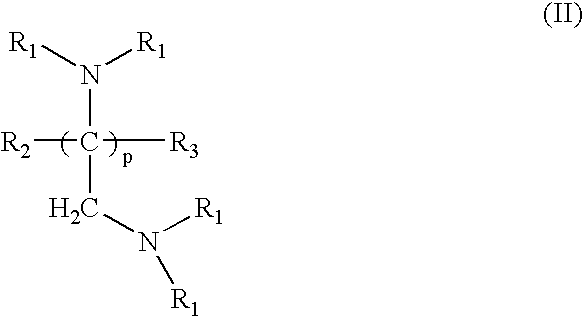Pharmaceutical compositions comprising crosslinked amine polymer with repeat units derived from polymerization of tertiary amines
a technology of tertiary amines and crosslinked amines, which is applied in the direction of drug compositions, synthetic polymeric active ingredients, organic chemistry, etc., can solve the problems of increased serum phosphorus levels, decreased excretion, and inability to control the compensatory mechanism
- Summary
- Abstract
- Description
- Claims
- Application Information
AI Technical Summary
Problems solved by technology
Method used
Image
Examples
example 1
Libraries of Crosslinked Polymers Formed in a Bulk Solution Process and Measurement for Phosphate Binding Capacity
Creation of Polymer Libraries
[0059] The following five examples each comprise a library comprising up to 24 crosslinked polymers. Polymers were prepared in batch reactors arranged in a 4×6 array format. Each reactor had either a 350 microliters or a 3 ml volume, was magnetically stirred, and temperature-controlled. In a typical procedure, amine, crosslinkers, solvents and optionally base were dispensed robotically in each reactor, optionally under agitation. The reactors were then sealed and heated up to the indicated temperature for 15 hours. The reactor array was then dismounted and plugs of crosslinked polymers transferred in glass vials, ground, washed repeatedly with de-ionized water, and lyophilized. The five libraries are identified below in Table 3 along with the corresponding reaction conditions used in their creation.
TABLE 3ReactionLibrarytemperatureReacto...
example 2
Synthesis of 1,3-Diaminopropane / Epichlorohydrin Crosslinked beads Formed in a Suspension Process
[0066] A 3-liter reaction vessel was used, comprising a three necked round bottom flask with four sides baffles. The reaction flask was equipped with an oil heating bath, cold-water reflux condenser, and mechanical stirrer with a 3 inch propeller. To this reaction vessel was introduced a solution of 1,3-diaminopropane (90.2 g, 1.21 mole) dissolved in 90.2 g of water, surfactant (branched dodecylbenzene sulfonic acid sodium salt, 6.4 g dissolved in 100 g of water) and 1 Kg of toluene. This initial charge was agitated to 600 rpm for 2 minutes and then lowered to 300 rpm for 10 minutes before the epichlorohydrin was added. The 300 rpm speed was maintained through out the remainder of the experiment. The solution was heated to 80° C. and also maintained at this temperature through out the experiment.
[0067] In a separate vessel, a 40 mass % solution of epichlorohydrin in toluene was prepared...
example 3
Synthesis of 1,3-Diaminopropane / 1,3-Dichloropropane Crosslinked Polymer
[0069] Using water as solvent, 1000 mg of B-SM-22-DA was mixed with 1524 mg of X—C1-3 and 2524 mg of water in a 20 mL scintillation vial. The reaction was subjected to magnetic stirring and maintained at a temperature of 80° C. overnight, followed by a temperature of 90° C. for two additional hours. A 34 wt. % of reaction mixture (1716 mg) was purified by 3 washing in water / centrifugation steps and gave 144.7 mg of powder of the polymer of the present example.
PUM
| Property | Measurement | Unit |
|---|---|---|
| molar ratio | aaaaa | aaaaa |
| molar ratio | aaaaa | aaaaa |
| molar ratio | aaaaa | aaaaa |
Abstract
Description
Claims
Application Information
 Login to View More
Login to View More - R&D
- Intellectual Property
- Life Sciences
- Materials
- Tech Scout
- Unparalleled Data Quality
- Higher Quality Content
- 60% Fewer Hallucinations
Browse by: Latest US Patents, China's latest patents, Technical Efficacy Thesaurus, Application Domain, Technology Topic, Popular Technical Reports.
© 2025 PatSnap. All rights reserved.Legal|Privacy policy|Modern Slavery Act Transparency Statement|Sitemap|About US| Contact US: help@patsnap.com



